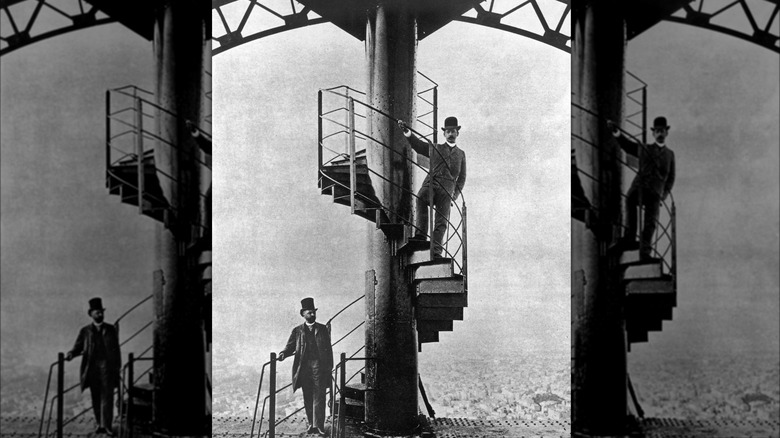The Secret Spot You Should Check Out In The Eiffel Tower On Your Paris Trip, Per Rick Steves
If you can't get enough of cities like Paris and envy those who call the French capital home, know that there is an address that even Parisians living in Gros-Caillou, the neighborhood at the heart of the city of love, are jealous of. The address in question is a small apartment located near the top of the Eiffel Tower, and the man it belonged to was the designer of the iconic monument — Gustave Eiffel.
Per travel guru Rick Steves, a leading authority on places to visit (and avoid) in Europe, this secret apartment is one of the Eiffel Tower's highlights. Despite being implored by many and even being offered small fortunes to let out the one-of-a-kind apartment for just a night, Eiffel never let anyone else use it and only hosted very select visitors, a notable one being Thomas Edison.
After being closed to the public for years, the apartment can now be peered into through a glass window. The seated wax figures of Eiffel and Edison aside, it's the rest of the apartment that is interesting to soak in because of how remarkably quaint it looks despite being situated at one of the world's most iconic addresses. The simple layout is partly because Eiffel spent the latter years of his life in the tower conducting research in a variety of fields. His apartment is only part of the secret — the Eiffel Tower was meant as a tool for scientific research from the start!
Gustav Eiffel's secret apartment is on the Eiffel Tower's top level
Despite being criticized by several luminaries during its construction for seemingly going against the architectural aesthetics of the city, the Eiffel Tower captured people's imaginations once it was finished in 1889. This made Gustave Eiffel's (not so) secret apartment at its very top all the more fascinating. Author Henry Girard mused in his book La Tour Eiffel de Trois Cent Métres (via Room One Thousand) about living up there: "In the daytime, he can look out on the splendors of Paris... At night, in the clouds, soothed by the singing wind, he falls asleep by the light of the eternally watchful stars. Is there anyone who can describe to us the dreams that he has in his heavenly residence?"
The apartment, while not large, has wood paneling, wallpaper, and velvet-upholstered furniture. It consists of living and dining areas, a workshop, a kitchen, and a bathroom. Interestingly, it doesn't have a bedroom. You're unlikely to see more than a few of the tower's 18,000-odd metallic parts in it. However, a colossal metal beam running through the apartment is a stark reminder of its location. A ticket to the top floor lets you peek into the apartment. You can grab a flute of bubbly from the champagne bar and marvel, like Girard and countless others, at the prospect of living in these one-of-a-kind living quarters (but watch out for common Paris scams like the spilled beverage distraction)!
The Eiffel Tower was also a science lab
When visiting the Eiffel Tower, take a moment to consider how fortunate one is that it is still standing. The tower was originally meant to be demolished in 20 years and survived largely because Gustav Eiffel presented it as a tool for scientific research. It was originally built for the 1889 Exposition Universelle or Paris World Expo to explore the possibility of building a structure that stood at the then landmark height of 1,000 feet. The finished Eiffel Tower held the world record for the world's tallest tower for over 40 years until it was dethroned by the New York Chrysler Building. Apart from being a global icon, the tower was ideal for scientific experiments that weren't possible at lower heights and smaller scales.
Thus, right outside Gustave Eiffel's famed apartment were several scientific instruments he used for research. His studies ranged from aerodynamics to meteorology, gravity, radio transmission, and more. At one point, he installed a wind tunnel at the foot of the tower to test early airplane designs. During World War I, radio equipment installed in the tower successfully intercepted communications. In the following years, it was used to transmit radio programs and even television signals. While romanticizing the Eiffel Tower is inevitable, as is the prospect of living at the top of it, the tower and its designer both seemed much more steeped in scientific inquiry and practicality than living up to Parisian glamor. Now, you can enjoy both.


